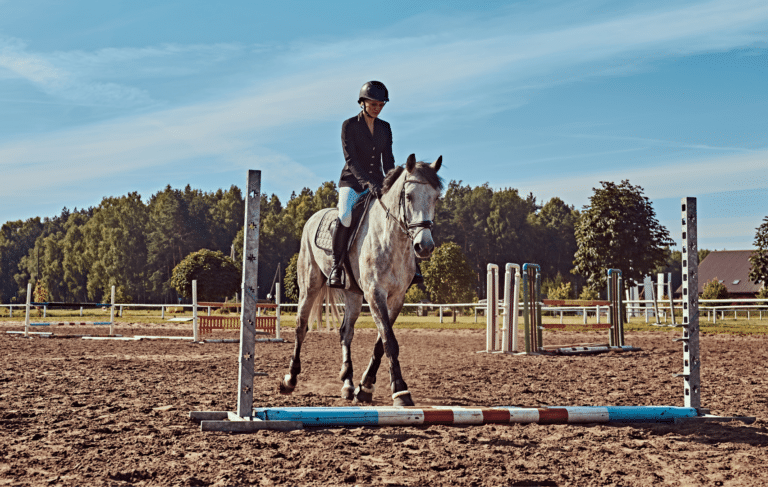Exercises that use poles on the ground (or raised poles) might seem like they are just for jumpers. In actual fact they have a plethora of benefits for horses of all disciplines and training stages and can be helpful for their riders too.
How pole work can help your training
From a physical perspective, pole exercises help your horse in a number of ways.
- Balance and coordination: Your horse has to work harder to maintain balance through the exercise.
- Strength: Pole work strengthens your horse’s core muscles which in turn stabilises their back and pelvis.
- Suppleness: Pole work asks for an increased range of motion in the horse’s movement, helping to make them looser and more supple.
Beyond physical development, poles can assist with:
- Maintaining the rhythm
- Keeping your horse’s attention and making a session more interesting
- Adjusting stride length
- Helping you ride more accurate lines
Riding a poles exercise: the basics
While there is an unlimited number of exercises you can setup, there are a few fundamentals to riding a line of poles that will ensure you and your horse get the most from the exercise.
Establish your walk/trot/canter beforehand
Poles are meant to improve and develop the paces, so make sure you have setup a half decent pace to improve upon! Establish your rhythm, keep a contact, and use half halts to help your horse stay connected. If you have intentionally set the distance a little short or long, set up the pace and stride length you wish to ride the poles at beforehand.
Let your horse figure out the exercise
Once you have begun the exercise, ideally you will let it teach your horse without you interfering (as always, there are exceptions). Maintain your position with leg and rein contact, but don’t try and ‘help’ him through the exercise. You will interrupt his rhythm and stop him from learning how to use his body correctly for a smooth path through it.
Ride an accurate line
In most exercises, we want to ride in the middle of each pole. For a straight line, this means keeping the horse straight and riding through the middle. For a fan of poles on a circle, this means maintaining the correct degree of bend to meet the centre of each pole. Drifting will change the length of stride your horse has to take between each pole and prevent him from getting the full effect of the exercise – not to mention being a tell-tale sign you have some work to do on straightness.
Look up
Seemingly small but very significant – keep your eyes up ahead! Looking down shifts your centre of gravity forward and stops you using your driving aids effectively. It can also make some riders tense up without realising, causing your horse to rush. Pick something in the distance to look at and feel what your horse is doing underneath you rather than looking down at him.
Setting up: distances between poles
When you set up a series of poles, start with them at a comfortable distance for your horse. For most horses, of around 16 hands high, the distance will be approximately:
Walk: 0.8 to 1 metre
Trot: 1.2 to 1.5 metres
Canter: 2.7 to 3.3 metres
Getting started: line of poles in walk and trot
If you or your horse is fairly new to pole work, a good place to start is with a simple line of four poles set to walk or trot distance. For green horses, start with one or two poles before gradually building up to four. Start by riding through the middle of the poles, maintaining your rhythm and keeping your horse straight by imagining you are forming a tunnel between your legs and reins.

Once you are doing this consistently, you can mix it up by slightly shortening or lengthening the distance between each pole.
Another variation is to ride the line of poles on an angle, starting on the right side and heading towards the left side, then vice versa. Make sure you keep your horse’s body straight on the line you are riding. Again, looking up to wherever you’re heading will help a lot with this. Angling the poles is great for horses who are a little stiff or short in their stride, as the extra distance they need to cover on an angle helps increase range of motion. It also demands more concentration from the horse, as they have to focus harder on where they are putting their feet than they do when heading down the middle.

Things to remember
- Build up slowly: Introduce exercises progressively; particularly if your horse finds them demanding.
- Include frequent rest breaks: Doing pole exercises on a fatigued horse will cause more harm than good. Make sure you gauge how well your horse is coping and include a break whenever you think he needs one. If your horse is really struggling with an exercise, give him a break when there is even a small improvement, rather than waiting until he gets it right.
- Spend an even amount of time on each rein: Make sure you do an even amount on each rein to equally develop both sides of the horse. As a general rule, for pole exercises on a straight line, it is a good idea to track a different direction each time so the horse doesn’t begin to anticipate which way he is going.
In the next article we will explore some exercises to help improve your horse’s balance and suppleness.


